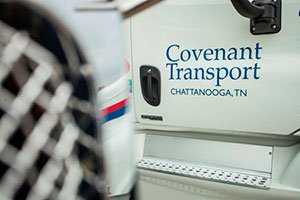Covenant Transportation Earnings Fall

Net income at dry van and refrigerated carrier Covenant Transportation Group fell by more than 50%, year-over-year, for both the fourth quarter and the full year, the Chattanooga, Tennessee, truckload fleet reported Jan. 25.
Revenue also declined by more than 5% for the quarter and the year due to the softening of business conditions since 2015.
For the quarter, Covenant earned $5.98 million, or 33 cents a share, on revenue of $191 million, compared with $13.2 million, or 73 cents, on revenue of $208.1 million during the final three months of 2015.
RELATED: Covenant CEO says truckers willing to pay to upgrade highways
“The trucking environment in the fourth quarter improved sequentially compared with the third quarter of 2016,” Covenant Chairman and CEO David Parker said.
“The peak freight season was more condensed than in 2015 as rapidly growing e-commerce sales continue to compress the holiday inventory stocking and delivery season. This year, the pace of freight and need for our value-added expedited services was concentrated largely between the week of Thanksgiving through Christmas Day, which was shorter than the past two peak seasons,” Parker said.
Covenant ranks No. 43 on the Transport Topics Top 100 list of the largest U.S. and Canadian for-hire carriers.
While quarterly miles per tractor rose by 2.4% to 30,856, freight revenue per loaded mile declined by 6.6% to $2.027.
The company’s supply of tractors on Dec. 31 was 2,535, down 4.6% from the end of 2015.
For the year, Covenant had net income of $16.8 million, or 92 cents a share, on revenue of $670.7 million, compared with $42.1 million, or $2.30, on revenue of $724.2 million in 2015.
Looking forward, chief financial officer Richard Cribbs said, “We are forecasting sequential improvement throughout the year. In the first half of 2017, we do not expect to match the earnings per share levels we generated for the first and second quarters of 2016.
“However, we believe the combination of an improving economy, growth of time-sensitive e-commerce freight, industry regulatory changes, retail inventory declines . . . and operational progress at [Southern Refrigerated Transport] should deliver earnings improvement that result in higher earnings for the second half and potentially the full year of 2017,” Cribbs said.


